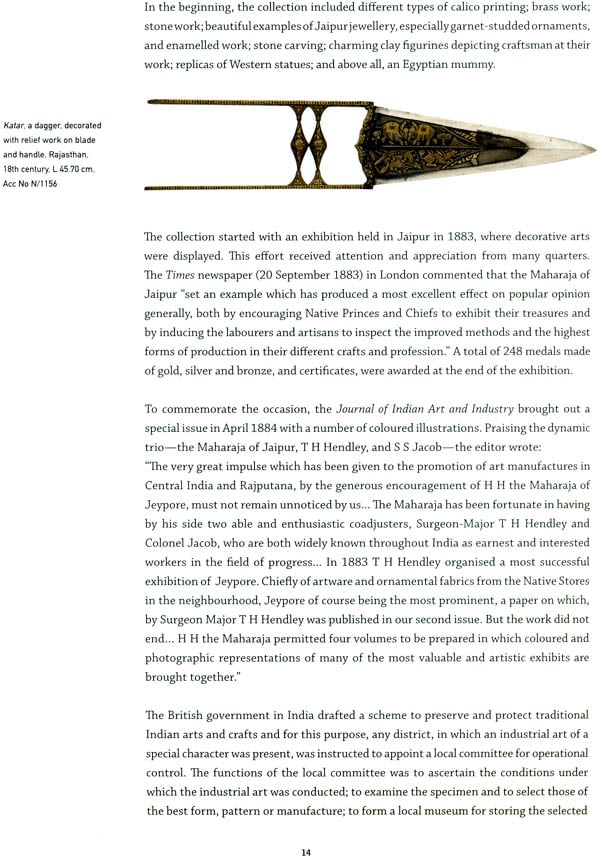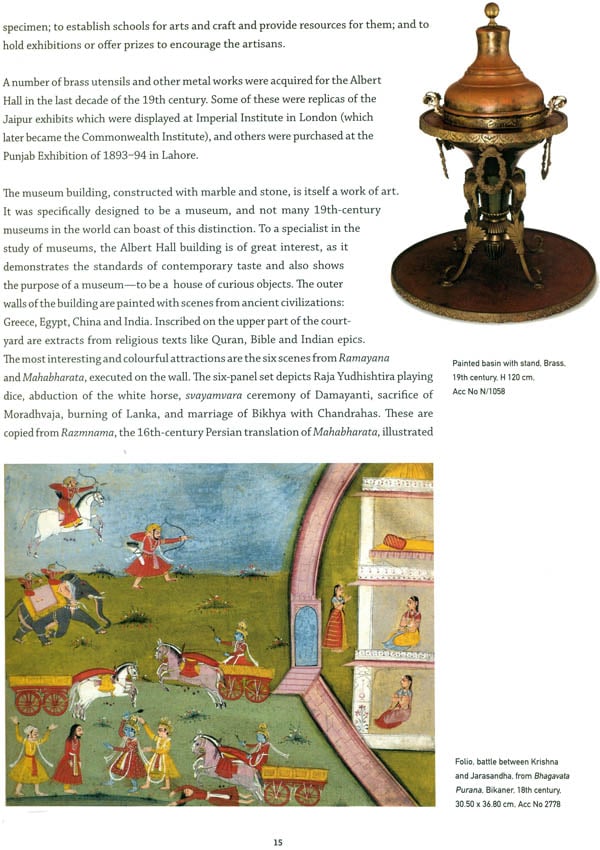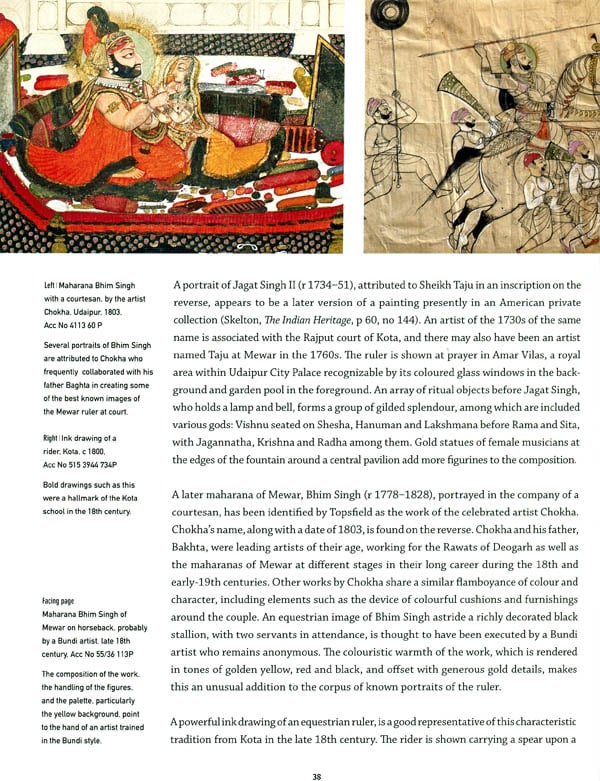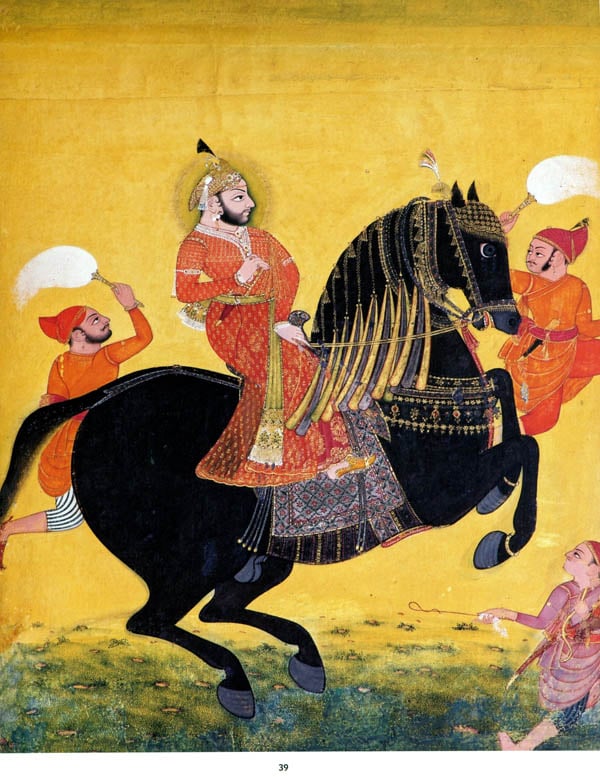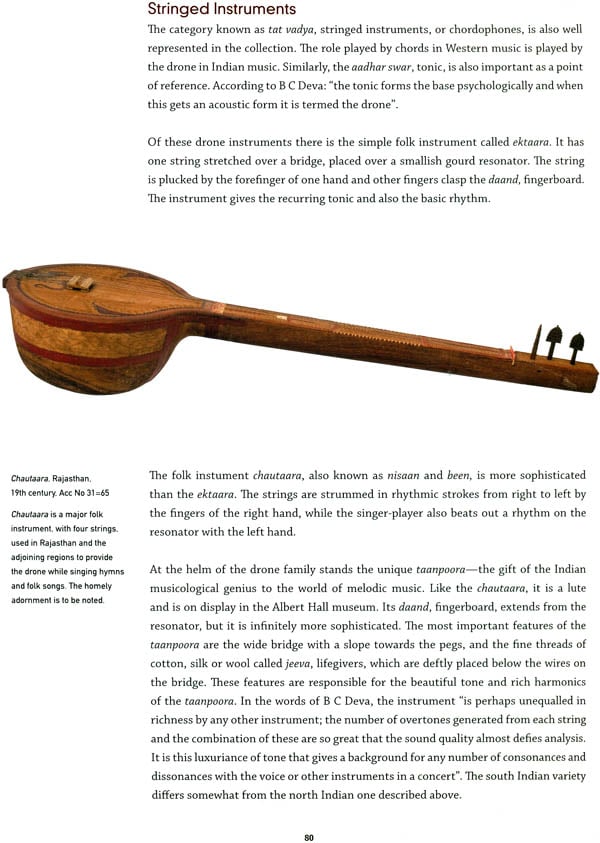
Treasures of The Albert Hall Museum (Jaipur)
Book Specification
| Item Code: | NAK978 |
| Author: | Chandramani singh |
| Publisher: | Mapin Publishing Pvt. Ltd. |
| Language: | English |
| ISBN: | 9788189995263 |
| Pages: | 119 |
| Cover: | Hardcover |
| Other Details | 12.0 inch x 9.0 inch |
| Weight | 1 kg |
Book Description
The Albert Hall Museum in Jaipur, Rajasthan, is one of the finest museums of the 19th century. It was envisioned by Maharaja Sawai Ram Singh II and executed by his successor Sawai Madho Singh II at a time when Jaipur was making a transition from the feudal era into a modern and model state.
In the atmosphere of change, which spurred a desire to preserve the heritage of local arts and crafts, the vision for the museum was brought to life by Thomas Holbein Hendley. The repository of 19,000 objects collected by him is a valuable inheritance today: arms and armour, sculpture, international art, pottery, stone work, wood work, ivory, jewellery, clay models, musical instruments, coins and seals, carpets, and miniature paintings.
The museum is home to the rare Persian Garden Carpet and also an Egyptian Mummy. The Albert Hall building, designed and built by Sir Samuel S Jacob in 1887, is itself one of the best examples of Indo- Saracenic architecture in India, combining elements of Mughal and Rajput styles. Although it was christened "Government Central Museum, Albert Hall, .Iaipur" after India's independence, it continues to be known simply as "Albert Hall Museum".
It was opened to public in July 2008, after renovations that lasted 14 months. Tourists, students, historians, artists and artisans now have the opportunity to experience the range of 19th-century Industrial Arts, in a modernized and technologically advanced environment.
Edited by Dr Chandramani Singh, this catalogue presents a selection of the treasures that are on display at Albert Hall, Jaipur.
The transformation of Albert Hall from a home for dioramas to a resurrection of Colonel Thomas Holbein Hendley's vision of creating an industrial arts museum, took several years of multiple efforts. The ovation of Albert Hall-one of the finest 19th-century museums, curated by Hendley in the latter half of that century-was completed in July 2008. The modernized museum retains the spirit of the original, yet takes advantage of the precepts of modern museology with the help of technological advances in conservation, repair and restoration.
The Albert Hall now boasts of a metal room, an arms-and-armour gallery, a sculpture gallery, displays of international art, pottery, stone art, wood work, ivory, jewellery, clay models, musical instruments, coins and seals, carpets, and galleries for miniature paintings. Many of the original wall-built showcases were built by Wimbridges in Bombay, which were modelled on the lines of showcases at the South Kensington Museum, now known as V&A Museum, in London, have been retained to house the display. The collection is complemented with a well-documented index, compiled with the help of catalogues and the abundant literature available on crafts of Jaipur. The museum has also introduced enhanced security; better signage, and lighting and audio systems.
Authorities on museology at the prestigious Metropolitan Museum of Art in New York advised us to develop a theme for the museum. The renovations have thus focused on highlighting the industrial arts theme developed by Hendley in the 19th century.
At that time, Jaipur was experiencing a progression from the feudal to the modern age, under the rule of the reformist king, Maharaja Sawai Ram Singh II (r 1835-80), and his successor, Sawai Madho Singh II (r 1880-1922). It was the former's vision which led to setting up of Jaipur School of Art in 1866 for developing the industrial arts of the time. Sawai Madho Singh II carried forward this vision, and all other modernization plans of his predecessor.
It was in this atmosphere of change and reform that Thomas Hendley came to Jaipur as the residency surgeon, as did Samuel Swinton Jacob, a young military engineer, who came to head the new public works department (PWD) which was set up in 1860. They provided vision and expertise for the realization of the maharajas' reform projects. Quite apart from his professional duties, Hendley was instrumental in setting up an observatory and a meteorological centre, but his real passion was to work towards preserving and developing the local industrial arts and crafts. His proposal to set up a museum was accepted by Maharaja Sawai Madho Singh II, and came into existence at a temporary accommodation in 1881, in Naya Mahal.
Hendley's meticulously compiled ledger-entry of every collected item is the backbone of our inventory and an important source material to this day. The range of objects collected include metalware: vessels, salvers, plates with engraving, repousse work, etching and carving, and they were local, pan- Indian and from the neighbourhood: pottery, stone carvings, woodwork, lacquer work, clay models, textiles, musical instruments, ivory carvings, arms and armour, and jewellery. Eventually, about 19,000 objects were collected, and their particulars were published in a catalogue. This passion for detail was not un usual for the Victorian Age, when analyzing, documenting and categorizing were considered signs of a scientific temperament. It is a remarkable facet of the museum's character that it acted somewhat like a library does. Objects could be borrowed by master craftsmen and returned.
Hendley was concerned that traditional arts retain their authenticity and not suffer modification on account of Western influences. The School of Art in Jaipur, which now exists as Rajasthan School of Art, became a workshop to preserve and develop the skills of artisans. Metal artisans were encouraged to study the shapes and forms of vessels whose outlines appeared in the niches at Sheesh Mahal in Amber Fort. Extraordinary vessels and salvers were designed and produced, depicting deities and signs of nakshatra, stars.
The art of koftkari, damascening steel weaponry with inlay of gold and silver, for which Jaipur is well known, interested Hendley greatly. He went on to write a book, Damascening on Steel or Iron as Practiced in India in 1892, published by W Griggs of London, and documented the best examples of the art. He believed that Jaipur had the best craftsmen of this art. He thought the same of .Iaipur's minakari, art of enamelling, that it was far superior to anything not only in India but in Europe and Persia too. Jaipur is renowned for minakari work on gold jewellery. Hendley and Jacob published a book, Jeypore Enamels, in 1886, with lithographs by W Griggs, which documented masterpieces from as far back as the 16thcentury.
2. In 1905, Hendley published his last book, on Asian carpets, after his return to England upon retirement. He had made a reference in this to a large carpet depicting paradise with flowers, birds, trees and animals. It is likely that he was referring to the magnificen t 17th - century Persian Garden Carpet which was discovered at Amber Fort in 1937 and later acquired by the museum. It now has a pride of place in the Albert Hall collection as it is the finest carpet of its kind in the world. Hendley also sought to develop the art of carpet-making by arranging for some of the finest specimens to be reproduced in the jails. Many of these are also on display.
It was a time when schools of art were sprouting all over India and there was great interest in traditional pottery, combined with the desire to develop new techniques from the East and West. Glazed pottery was in its infancy in Jaipur at the time. Maharaja Sawai Ram Singh II invited Dr Alexander Hunter from Madras School of Art to survey the art of pottery in Jaipur and advise on improvement. By 1876, a class for glazing pottery was started at the Jaipur School of Art. The director of the school, Opendronath Sen, devoted his energies to the development of the blue-glaze pottery in Jaipur. At the famed Calcutta International Exhibition of 1883-84 and the Jaipur Exhibition of 1883, Jaipur School of Art won several awards for fine specimens of pottery, and soon after, .Iaipur's blue pottery became a flourishing industry. The museum began collecting both traditional and modern pottery from all pottery-making centres in India. This collection, catalogued by Hendley, makes the Albert Hall pottery collection one of the finest 19th-century collections in India.
Hendley had collected pottery and ceramics from Central Asia, Europe and the Far East. We have identified some superb specimens of Doulton, Wedgwood, Minton and Japanese Kinkosan pottery among these. The Hungarian pottery in the collection was discovered to be masterpieces of 19th-century Zsolnay pottery. Furthermore, an entire representative collection of Egyptian relics including bronze figures, terracotta objects, ceramics and jewellery, and an Egyptian mummy in its coffin, were acquired and are now on display. The collection of 19th-century stone sculptures of gods and sages appearing in the catalogues indicate that the art of stone sculpting was well-developed and had undoubtedly provided images for temples and homes throughout India. Stone carvings were also on display at the Jaipur Exhibition of 1883.
The other important name in the history of Albert Hall is that of Sir Samuel Swinton Jacob, who designed and built the museum. He had come to Jaipur in 1867 to head the PWD, but made his mark in designing and building several important buildings including Naya Mahal. Jacob was asked to design and construct the memorial building in honour of the visiting Prince of Wales, Edward VII, who had laid the foundation stone for it in 1876. With support of his chief overseer Tujumul Hoosein, artist Ram Baksh, draughtsmen Shanker Lal and Chote Lal, and principal masons Chander and Tara, Jacob set about building Albert Hall in 1881. He sent his staff to study Mughal monuments located in Delhi, Agra, and Fatehpur Sikri to gain inspiration in producing the best designs-both Mughal and Rajput. The magnificent structure, which was completed in 1886, was done in the best of Indo-Saracenic traditions.
The royal durbar decided that Albert Hall would become a permanent home for Hendley's collection of industrial arts and so the museum moved out of its temporary accomodation at Naya Mahal to the Albert Hall in Ram Niwas Bagh. By February 1887, the new museum was ready for its inauguration and was itself an intrinsic part of the display as it represented architectural designs, both local and Mughal. The structure- pillars, brackets, arches and ornamentation-was representative of the art of stone carving, serving as examples of the art without requiring a gallery display. The School of Art went on to publish 12 portfolios, replete with designs of plinths, columns, doors, brackets, arches, balustrades, chhatris, cenotaphs, and jharokas, decorated parapets, and incorporating almost every facet of Mughal and Rajput buildings. These became valuable reference material for architects and designers.
Yet another unique element of Albert Hall is the murals representing the different civilizations of the world. The Indian themes in these murals include illustrations of the Ramayana from Razmnama, and the frescos of the Ajanta caves. European, Greco- Roman, Babylonian, Far Eastern and Pharaonic civilizations are also represented. The courtyards and corridors are replete with aphorisms and quotations of poets, sages and philosophers.
In the light of this historical backdrop, the museum is indeed an inheritance from the past. These arts, as they have developed today, owe much to the noble efforts of Maharaja Sawai Ram Singh II and Maharaja Sawai Madho Singh II, and to Hendley and Jacob.
Among those visiting the renovated museum, the tourist would have a glimpse of the entire range of industrial arts of the 19th century; the artisan would have a unique opportunity to study rare examples of the finest workmanship, possibly even be inspired to experiment and reintroduce what may now be antiquated; the historian could register inspirations of an earlier age; the student of art and crafts could research specific areas of interest; and the artist and aesthete could simply sit back and enjoy art and culture at its best.
It is appropriate to acknowledge the leadership and guidance provided to the project by successive secretaries of art and culture of the Government of Rajasthan. In the initial phase, Ashok Shekhar successfully grappled with the seemingly endless issues and problems, which appeared insurmountable at the time. The succeeding Secretary of Art and Culture, Salauddin Ahmad, carried the project foreword with visionary zeal and determination, overcoming all obstacles to its successful culmination. In this he was ably assisted by the remarkable energy of B L Gupta, Director, Department of Archaeology and Museums, coordinating the worthy efforts of a diverse team of experts, engineers and artisans, and attending to administrative minutiae. We also relied on the invaluable support and expertise of the eminent art historian and museologist, Dr Chandramani Singh, Director at Jawahar Kala Kendra, Jaipur, for historical detail and accuracy, and Kristine Michael for her encyclopedic knowledge of Indian pottery. We are indebted to all the eminent members of Rajasthan State Museums and Monuments Management and Development Society, particularly Apurv Kumar, R K Poddar, Pramod Kasliwal and B G Sharma for their individual expertise and enthusiastic participation in the project. We are also fortunate in having a young, dynamic and dedicated curator in Rakesh Chholak, who showed amazing skill in translating ideas for design, decor and display of objects, from the drawing board into faithful actuality, almost instantly, as if with a magic wand.
| Foreword | 6 |
| Albert Hall | 12 |
| Enigmatic Discoveries | 18 |
| Chiselled Marvels | 22 |
| Imagined Realms | 32 |
| Earthen Jewels | 48 |
| Engraved Epics | 58 |
| A Regal Panoply | 68 |
| Melodic Splendours | 78 |
| Threads and Needles | 88 |
| Knotted Flowers | 98 |
| Timeless Art | 108 |
| Bibliography | 118 |
| Acknowledgements | 119 |
